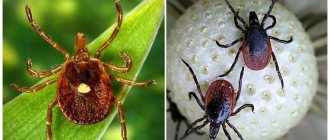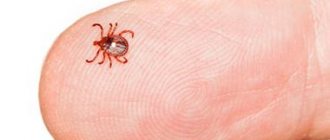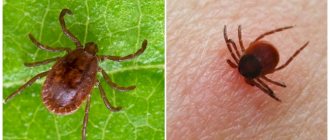The risk of contracting tick-borne encephalitis while in a tick habitat remains throughout the warm period of the year, but the likelihood of getting bitten by an infected tick is much higher in endemic regions. Let's find out which regions of the Russian Federation are endemic for tick-borne encephalitis, and which of them are the most dangerous during the period of tick activity.
An area endemic for tick-borne encephalitis is an area in whose ecosystem the causative agent of tick-borne encephalitis is constantly present, and almost every season there are cases of encephalitis in people bitten by ticks in this region.
The carriers of encephalitis are ixodid ticks. The endemicity of a region is formed as follows: ticks and warm-blooded animals living in this region regularly become infected with the virus from each other and become carriers of the disease. In this case, neither ticks nor animals die from encephalitis, but are only intermediate hosts of the virus.
This virus simply exists in their bodies and is passed on from generation to generation. But if an infected tick bites a person, the person in most cases becomes seriously ill. The tick can also infect farm animals, such as cows. If a person drinks milk from an infected cow, he will also get encephalitis.
How much higher is the likelihood of infection in an endemic area?
The risk of contracting tick-borne encephalitis in an endemic area is much higher than the average throughout the entire habitat of ixodid ticks. From 2 to 10% of ticks are carriers of the dangerous virus. Despite the measures taken, up to several dozen cases of tick-borne encephalitis are recorded per season, and some cases are fatal.
Wasp, hornet, bee...
If you have an allergy, the bite of nectar hunters can be fatal. But those who, for example, disturb a nest of wasps or hornets will not be in trouble. It's all about the number of bites, and therefore the dose of poison received. In the picture: the common hornet (lat. Vespa crabro). Despite its impressive size (up to 35 mm), the hornet is considered less aggressive than the wasp.
Dangerous animals in Germany
The most dangerous regions of Russia for tick-borne encephalitis
Traditionally, the most dangerous areas for the likelihood of encephalitis are considered to be:
- Siberia;
- Ural;
- Far East.
Here are the main foci of tick-borne encephalitis, but cases of disease are also common in the middle zone, the Volga region and in the north-west of Russia. Endemic areas within all these zones are located unevenly: there are relatively favorable and extremely dangerous areas, delineated by climatic zones or landscape features.
Tick-borne encephalitis
Encephalitis
Tick bite
Vomit
6520 01 February
IMPORTANT!
The information in this section cannot be used for self-diagnosis and self-treatment.
In case of pain or other exacerbation of the disease, diagnostic tests should be prescribed only by the attending physician. To make a diagnosis and properly prescribe treatment, you should contact your doctor. Tick-borne encephalitis: causes, symptoms, diagnosis and treatment methods.
Description
Tick-borne encephalitis is a dangerous viral infection that occurs in persistent natural foci and is manifested by high fever, intoxication and damage to the nervous system.
Causes of tick-borne encephalitis
The cause of the disease is an RNA-containing tick-borne encephalitis virus, which belongs to the genus of flavoviruses. Based on the composition of the genetic material and location of distribution, the Far Eastern, Ural-Siberian and Western subtypes are distinguished.
The virus is carried by ixodid ticks, which are also its main reservoir.
Thus, the virus is found where ixodid ticks live, the maximum increase in incidence is observed in May-June, and a second, less pronounced increase is recorded in late summer and early autumn, which is associated with the activity of ticks.
The virus cannot be transmitted from a person infected with tick-borne encephalitis to a healthy person.
The tick-borne encephalitis virus enters the human body in the first minutes of a tick bite or, which happens much less frequently, with the milk of an infected goat, or even less often, a cow. The virus initially multiplies and accumulates in the cells of the immune system, then enters the bloodstream and enters the lymph nodes, liver, spleen and other organs. There it multiplies and attacks the nerve cells of the cervical spinal cord, cerebellum, meninges, remaining there for a long time and penetrating deeper into the brain tissue.
Classification of the disease
The disease can occur in acute
or
chronic
form.
Non-focal acute forms are distinguished
, in the clinical picture of which it is impossible to identify a specific damaged structure of the nervous system, and
focal acute forms
with symptoms indicating the localization of damage to the nervous system.
The severity of the condition with tick-borne encephalitis can be mild , moderate and severe
.
Symptoms of tick-borne encephalitis
The incubation period (from the moment of infection to the first clinical manifestations) averages 7–12 days, but can vary from 1 to 30 days. Rarely during this period, precursors of the disease occur - general malaise, weakness in the muscles of the limbs and neck, numbness of the facial skin, headache, insomnia, nausea.
The disease begins acutely: with an increase in body temperature to 38–40°C, symptoms of intoxication (severe weakness, fatigue, sleep disturbances), as well as symptoms of irritation of the membranes of the brain (nausea, vomiting, severe headache, inability to press the chin to the chest ).
There is lethargy, confusion, redness of the face, neck, and upper half of the body. The patient may feel pain in the muscles of the whole body, most severely where movement disturbances will subsequently be observed; There may be numbness in areas of the skin or a sensation of crawling, burning, etc.
As the disease develops, the main symptoms appear, which determine its form. Most often, tick-borne encephalitis occurs according to the following clinical variants:
- in the form of fever
, lasting 3-5 days with symptoms of general intoxication, but without signs of damage to the nervous system. The outcome is a rapid recovery; - in the form of damage to the membranes of the brain
(most common in adults), which is manifested by unbearable headache, dizziness, nausea and vomiting that does not bring relief, photophobia; lethargy and lethargy appear. Body temperature is elevated, fever lasts 7–14 days. The prognosis is favorable; - in the form of damage to the membranes and substance of the brain
, when the symptoms of irritation of the meninges are accompanied by disturbances in movements in the limbs, including paralysis, visual impairment, hearing, speech, difficulty swallowing, etc. Sometimes convulsive seizures occur. The patient is poorly oriented in place and time, delusions and hallucinations are often observed. Recovery takes a long time, and movement disorders often remain for life. This is a severe form of tick-borne encephalitis, so death cannot be ruled out; - in the form of damage to the spinal cord
with the development of movement disorders (paresis and paralysis) in the muscles of the neck and limbs; - in the form of damage to nerve roots
and fibers with the development of disturbances in sensitivity and movement in the limbs.
Tick-borne encephalitis with a two-wave course of fever
is distinguished separately . The first rise in temperature is relatively mild, accompanied by symptoms of intoxication and irritation of the meninges, and the second (after a two-week break) with the development of a full clinical picture with signs of damage to the nervous system. Despite this, the prognosis is favorable, although transition to the chronic stage is possible.
Tick-borne encephalitis in children most often occurs in the form of fever or with signs of damage to the membranes of the brain.
Immunity to the virus after tick-borne encephalitis is lifelong.
Diagnosis of tick-borne encephalitis
To diagnose tick-borne encephalitis, it is necessary to confirm the fact of tick bite and the place where it occurred (find out whether the area is endemic for tick-borne encephalitis), clarify whether the patient has been vaccinated and whether immunoglobulin has been administered to him.
The doctor carefully examines the patient and conducts a complete neurological examination. It is important to exclude the possibility of other diseases, both infectious and non-infectious, accompanied by similar symptoms.
Laboratory diagnosis of tick-borne encephalitis includes determining the presence and increase in dynamics of the titer of IgM class antibodies and IgG class antibodies in the blood to the tick-borne encephalitis virus.
Complete list of endemic regions
Here is a list of regions of the Russian Federation where there is a constant risk of getting bitten by an infected tick (data for 2021):
- Altai;
- Amur region;
- Arkhangelsk region;
- Vologda region;
- Jewish Autonomous Region;
- Transbaikal region;
- Ivanovo region;
- Irkutsk region;
- Kaliningrad region;
- Kemerovo region.;
- Kostroma region;
- Krasnoyarsk region;
- O. Crimea;
- Kurgan region;
- Leningrad region.;
- Nizhny Novgorod region.;
- Novgorod region;
- Novosibirsk region;
- Omsk region;
- Orenburg region;
- Perm region;
- Primorsky Krai;
- Pskov region;
- Republic of Bashkortostan;
- The Republic of Buryatia;
- Republic of Karelia;
- Komi Republic;
- Mari El Republic;
- Republic of Tatarstan;
- The Republic of Khakassia;
- Republic of Udmurtia;
- Tyva Republic;
- Samara region;
- Saint Petersburg;
- Sakhalin region;
- Sverdlovsk region.;
- Tver region;
- Tomsk region;
- Tyumen region;
- Ulyanovsk region;
- Khabarovsk region;
- Khanty-Mansiysk Autonomous Okrug;
- Chelyabinsk region;
- Yaroslavl region
The territories are described in more detail, down to the districts, in the letter from Rospotrebnadzor.
The risk of getting bitten by an encephalitis tick varies in the regions listed above. For example, in Crimea and the Volga region, cases of the disease are recorded every few years, and in Siberia and the Far East, dozens of people die every year from tick-borne encephalitis.
Endemic areas of the Moscow region for tick-borne encephalitis 2021
In the Moscow Region, two northern regions are considered endemic. We are talking about Dmitrovsky and Taldomsky. In other areas, regarding encephalitis, people can be considered safe. however, this does not mean that all ticks that live there are harmless. Indeed, in addition to encephalitis, ticks can spread diseases such as:
- Tick-borne rickettsioses
- Human granulocytic anaplasmosis
- Human monocytic ehrlichiosis
- Ixodid tick-borne borreliosis
- Q fever
- Crimean hemorrhagic fever
- Siberian tick typhus
- Tularemia
- Babesioses
All these diseases are also quite dangerous. For example, infection with borreliosis occurs four times more often than encephalitis. Indeed, two years ago, one thousand seven hundred people became infected with encephalitis, while six and a half thousand of our compatriots became infected with borreliosis. Therefore, when planning a trip to the country or other outdoor recreation areas that are located in areas safe for encephalitis, you should not neglect protective equipment against ticks.
More on ShumCity.Ru:
Flax seeds: benefits and harm. How to take for treatment and prevention
Moreover, despite the fact that some areas are considered safe from encephalitis ticks, bites from these parasites also occur in such areas. The fact is that ticks can live wherever natural conditions are suitable for them. For their survival, it is enough to have good vegetation, humidity of about eighty percent and air temperature of about twenty degrees Celsius. These factors, with one degree of error or another, are the standard temperature for all Moscow region regions, therefore the risk of tick bites is everywhere. You can study in more detail the areas of the Moscow region and their level of danger in relation to encephalitis tick bites on the detailed map below.
Specifics of endemic areas
The localization area of the natural focus of the virus is constant, but its boundaries change from time to time, and within the range itself, areas free from tick vectors are sometimes formed.
This is partly due to climatic phenomena, due to which the number of ticks either rises or falls, for example - too hot and dry summers reduce the number of parasites, and a mild, warm spring helps to increase their numbers. The law of cyclicity also works: a sharp increase in the number of ticks is inevitably followed by a decline, so in different years these parasites become either more or less numerous.
Ticks concentrate mainly in the forest zone, preferring shady, cool corners with tall, dense grass. But some forest areas are so isolated that ticks are not able to penetrate their territory. An example is the mountainous Caucasus. There are forests and living conditions suitable for ticks, but there are no encephalitis ticks here, since they have not reached this region.
There are more ticks in the east than in the west
The degree of danger of contracting tick-borne encephalitis within the main tick habitat increases from west to east. Cases of disease are recorded especially often in the southern regions of the Far East. Most likely, this is due to humid, warm summers and the presence of mixed forests.
The most dangerous regions of the Far East:
- Amur region;
- Sakhalin;
- Khabarovsk region;
- Jewish Autonomous Region;
- Primorsky Krai.
What is characteristic: following warming, ticks move from east to west, and the peak of their numbers and activity in different regions varies throughout the season.
Incidence of encephalitis by region
If we compare the number of cases in different regions, the picture will also look heterogeneous.
Every year per 100 thousand people fall ill with:
- Up to 4 people in the northwestern federal district (Leningrad, Arkhangelsk regions).
- About 4-10 people in the Tver region and Khabarovsk region.
- Approximately 10-20 people – Khanty-Mansiysk, Tyumen, Omsk and Irkutsk regions.
- About 20-40 people - Chita, Ufa and Sverdlovsk regions.
- Over 40 people – Krasnoyarsk and Altai territories.
In the Far East, endemic areas have existed for hundreds of years, and the situation has not changed for the better. In contrast to this, in the European territory of the country, the number of people sick with tick-borne encephalitis is decreasing from year to year due to the anthropogenic factor (urbanization, land cultivation, landscape changes) and enhanced measures to combat the occurrence of the disease - vaccinations, the use of protective equipment.










